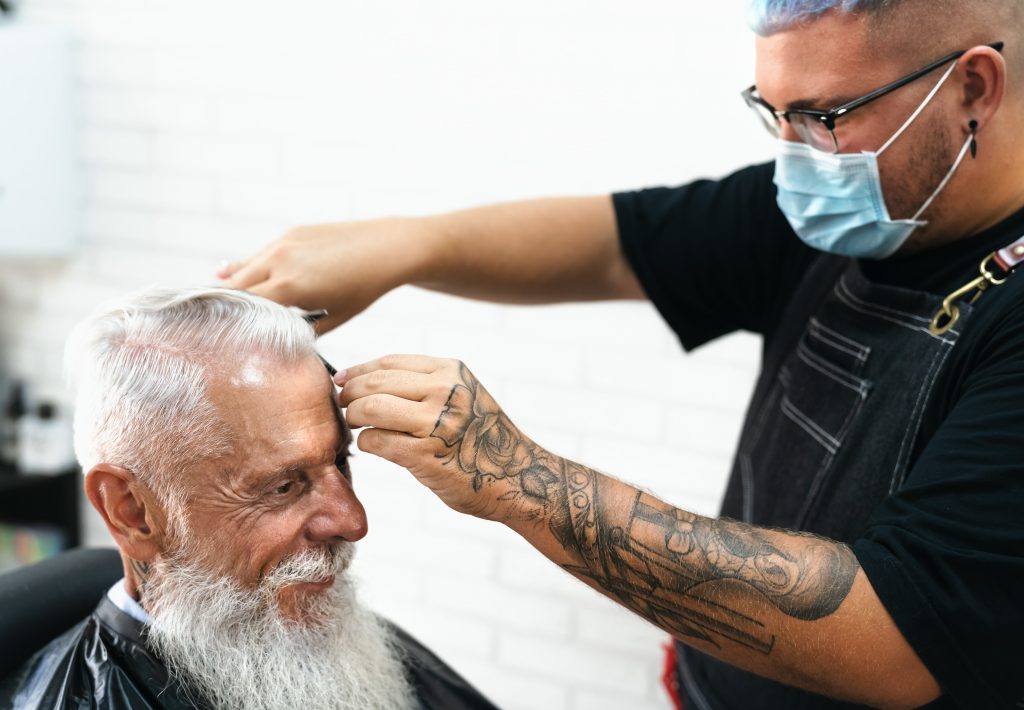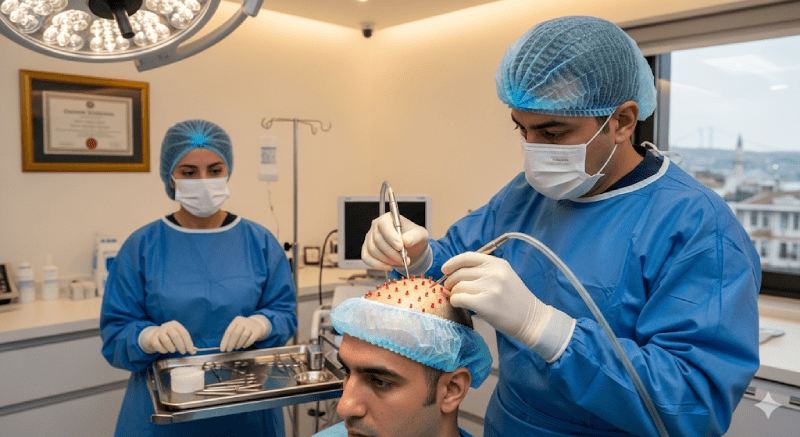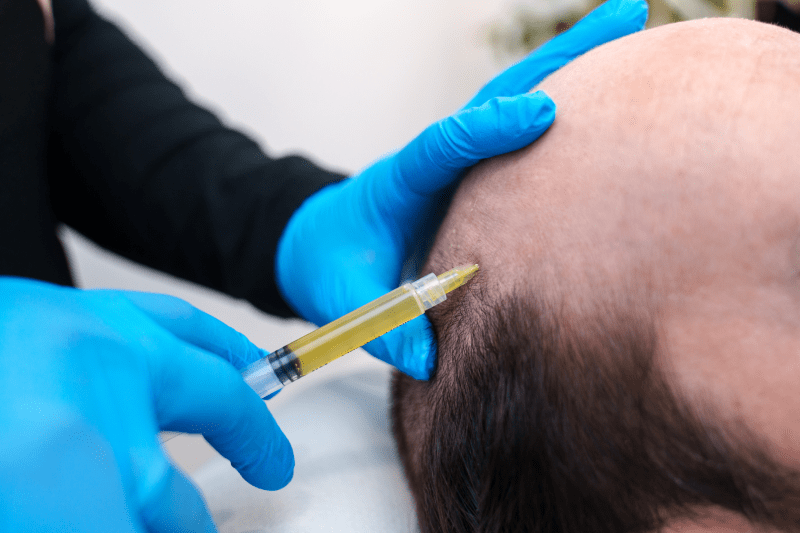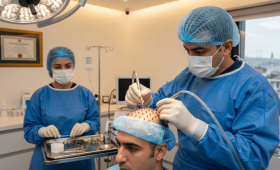What Is The Fundamental Difference Between FUE And DHI Techniques?
In the FUE (Follicular Unit Extraction) technique, hair follicles are harvested one by one, and micro-channels are first opened in the recipient area where these follicles will be placed. The follicles are then placed one by one into these channels. In the DHI (Direct Hair Implantation) technique, the follicles are immediately placed into the opened micro-incisions directly after being harvested, using a special tool called the Choi implanter pen. The fundamental difference is that in DHI, the channel opening and follicle placement processes are done in a single step with a single tool, making DHI a more delicate process.
Which Technique Offers A Denser Hair Transplant Possibility?
The DHI (Direct Hair Implantation) technique generally offers the possibility of a denser implantation per square centimeter compared to FUE. This is because the Choi pen allows specialists to implant hair with narrow and controlled angles even between two existing hair follicles. DHI is considered more advantageous for achieving natural density, especially in areas requiring density enhancement among existing hairs (densification) or in the front part of the hairline. However, the overall hair density also depends on the quality of the donor area and the number of grafts implanted.
Can Unshaven Implantation Be Done With The DHI Technique?
Yes, one of the most significant advantages of the DHI technique is that it allows for unshaven or partially shaven implantation. This is ideal, especially for female patients or male patients who want to enhance density in small areas. Since DHI can implant follicles directly between existing hairs, there is no need to shave the existing hair in the recipient area. In the FUE method, the recipient area usually needs to be completely shaved. This makes DHI appealing as it shortens the time required to return to social life.
Is The Recovery Period Longer In The FUE Technique?
The recovery period in the FUE technique may be slightly longer compared to DHI. Since the channel opening in FUE is done in a separate step, more micro-incisions are created in the recipient area, which can lead to slightly more scabbing. However, the fine blades used in the modern Sapphire FUE technique have minimized this difference. As DHI combines the channel opening and implantation, there is less tissue trauma, and scabbing can be less pronounced. In both techniques, the full healing period is typically around 10 to 14 days.
Does The DHI Technique Reduce The Risk Of Hair Follicle Loss?
One of the core claims of the DHI technique is that it reduces the risk of hair follicle loss by minimizing the time grafts spend outside the body. The Choi pen places the follicle directly into the recipient area immediately after harvesting, without waiting. This shortens the risk of the follicles being under-nourished and the duration of exposure to external factors. In the FUE technique, follicles are kept in special solutions until the channels are opened. Therefore, DHI has the potential for higher graft viability, although this depends on the team’s experience.
Which Method Is Better For The Natural Appearance Of The Hairline?
A natural appearance of the hairline is possible with both techniques (FUE and DHI), but this depends entirely on the specialist’s aesthetic vision and experience. DHI, thanks to the implanter pen, has the ability to implant grafts at very sharp angles (15-20 degrees), which creates a finer, softer, and more natural transition in the hairline. In FUE, achieving a natural appearance requires greater expertise and precision to capture the correct angle. In both techniques, placing single-rooted grafts at the front is mandatory for a natural result.

What Is The Price Difference Between FUE And DHI?
Generally, the DHI (Direct Hair Implantation) technique may be higher priced than FUE. This price difference stems from the cost of the special Choi implanter pens used in DHI, the fact that the operation takes longer, and the requirement for more specialized equipment and a larger team. FUE is more economical because the channel opening process is faster. However, due to the competitive advantage, centers in Turkey offer both techniques at prices far below those in Europe and the UK. The price difference varies depending on the package content and the number of grafts.
Which Technique Is More Suitable For Large Transplant Areas?
The FUE (Follicular Unit Extraction) technique is generally considered more suitable and efficient for large transplant areas (e.g., 4,000 grafts and above). Because the channels are opened in bulk in FUE, it allows for more grafts to be implanted in a shorter time compared to DHI. DHI requires each graft to be placed individually with the implanter pen, which takes longer and can tire the patient during large operations. Therefore, FUE is a more practical solution for patients with extensive baldness or a high level of shedding on the Norwood scale.
Which Technique Reduces The Risk Of Damage To Existing Hair?
The DHI technique reduces the risk of damage to existing hair follicles more effectively, especially when implanting among existing hairs. This is because the DHI pen pushes the surrounding tissue as it places the hair follicle, allowing for clear control of the recipient area. In FUE, opening the channels carries a risk of damaging existing follicles (especially in inexperienced hands). Therefore, prioritizing DHI may be a more logical choice for sparse areas where you do not want to lose your hair.
Which Technique Has A Lower Risk Of Scarring?
Both FUE and DHI techniques do not leave wide line scars (unlike the FUT technique). Both methods harvest grafts one by one using micro-punches (0.7-1.0 mm) from the donor area, and these small holes close naturally. Therefore, the risk of scarring is low in both techniques. However, because the incisions opened in the recipient area in DHI are narrower and more delicate, scarring and scabbing remain minimal in this region. The risk of permanent scarring is more related to over-harvesting in the donor area.
Why Does The DHI Technique Require A Larger Team?
The DHI technique requires a larger and more specialized team due to the precision of the procedure and time management. Since placing each graft carefully with the pen takes a long time, multiple specialists must work simultaneously to shorten the time grafts spend outside the body. While FUE can be done with fewer team members once the channels are opened, synchronous and coordinated work is mandatory in the DHI technique. This increases the operational cost of DHI.
At Which Stage Does The FUE Technique Store Hair Follicles?
In the FUE technique, hair follicles (grafts) are harvested one by one from the donor area and are kept in special, cold, and nourishing solutions (e.g., HypoThermosol) until the channels are opened in the recipient area. This waiting time is critically important for preserving the viability of the follicles. This period usually ranges between 1 to 4 hours. Since DHI implants the follicles almost immediately without waiting, managing the waiting time well in FUE is vital to prevent follicle loss.
Which Technique Has A Longer Operation Time?
Generally, the DHI technique has a longer operation time than FUE, especially for large graft numbers (over 3,000 grafts). DHI progresses slower because it requires each graft to be carefully placed into the implanter pen and implanted at a precise angle. In FUE, the placement phase is faster because the channel opening is done quickly. Patients may need to set aside a period of 6 to 9 hours for DHI surgery, while FUE may fall at the lower end of this range.

Which Technique Offers Easier Post-Operative Care?
Post-operative care and the first wash process are generally easier and smoother with the DHI technique. Since the incisions opened in DHI are narrower and more delicate, less scabbing is observed. This makes the first wash and scab shedding process more comfortable. In FUE, the amount of scabbing may be slightly higher due to the size and depth of the channels. However, meticulous adherence to the doctor’s washing instructions is essential for successful healing in both techniques.
Why Is DHI More Advantageous For The Angle And Direction Of Hair Follicles?
The DHI technique offers the possibility of millimetric adjustment of the hair follicle’s angle and direction during implantation, thanks to the sharp and cylindrical tip of the implanter pen. The specialist can rotate the pen to achieve perfect alignment with the natural direction of hair growth (15-45 degrees). In FUE, since the channel opening is independent of the follicle placement, achieving the correct angle requires more precision. DHI guarantees this precision in a single step.
Which Technique Is More Suitable For Hair Transplantation In Women?
The DHI technique is generally considered more suitable and practical for hair transplantation in women. Female patients usually do not want to completely shave their existing hair, and DHI is an ideal method that allows for unshaven transplantation. DHI can carefully implant grafts among existing long hairs, which facilitates the camouflage of the transplanted area after the operation. FUE can also be applied but usually requires partial shaving, which delays the return to social life.
Which Technique Has A Lower Risk Of Infection?
Both FUE and DHI techniques carry a low risk of infection when performed in modern and sterile hospital/clinic environments. However, because channel opening and graft placement are done simultaneously in DHI, the exposure of follicles to the external environment is minimized. This theoretically may slightly reduce the risk of infection. The actual determining factor is not the technique itself, but the clinic’s sterilization standards and the patient’s meticulous adherence to post-operative hygiene rules.
Can DHI And FUE Techniques Be Applied Simultaneously?
Yes, DHI and FUE techniques can be applied simultaneously using a hybrid approach, which can yield the best results in some special situations. For example, the FUE technique can be used to quickly cover a large portion of the extensive baldness area, while the DHI technique can be used to increase density in the front hairline or among existing hairs. This hybrid approach optimizes the operation time while using the most appropriate technique for the needs of each area.
Which Technique Has A Faster Donor Area Recovery?
Donor area recovery in both FUE and DHI techniques takes approximately 7 to 10 days. This is because grafts are harvested one by one using the same micro-surgical method (micro motor or manual punch) in both techniques. The healing speed depends on the diameter of the punch tip used (usually 0.7-0.9 mm) and the patient’s general health status. As long as over-harvesting is avoided in the donor area, no permanent scarring or long-term recovery issues occur in either technique.

Why Is DHI Recommended For Densification In Sparse Areas?
The DHI technique is highly recommended for densification in sparse areas because the implanter pen allows for precise placement of grafts among existing hair follicles without damaging them. Since channel opening in FUE carries a higher risk of damaging existing hair follicles, DHI is preferred. DHI implantation mimics the natural angle of existing hair, which makes it easier to achieve a more natural and dense result. This is a great advantage, especially for patients who do not want to lose their hair.
What Is The Advantage Of Sapphire FUE Technique Compared To DHI?
The Sapphire FUE technique uses special Sapphire blades instead of metal blades to open channels. Since Sapphire tips open sharper and smoother channels, there is less tissue trauma and faster healing. Compared to DHI, Sapphire FUE can open deeper, V-shaped channels that allow the follicle to settle better. DHI, on the other hand, offers the ability to implant at narrower angles. Sapphire FUE is generally used for dense implantation in large areas, while DHI is preferred for hairline sensitivity.
Which Technique Has A Higher Risk Of Graft Dislodgement?
The risk of graft dislodgement is present in both techniques, especially in the first 48 hours after the operation. However, the follicles placed into the channels in the FUE technique may be less firm initially compared to DHI. In DHI, the pushing force of the implanter pen ensures the follicle sits tightly in the channel, theoretically leading to a lower risk of dislodgement. In both techniques, avoiding trauma and touching the recipient area after the operation is the most important rule that completely eliminates the risk of dislodgement.
What Is The Most Important Factor Determining The Success Of The Technique?
More than the technique itself, the most important factor determining the success of the hair transplant operation is the experience, artistic skill of the doctor and the team performing the procedure, and the quality of the technology used by the clinic. An experienced team can naturally design the hairline, place the follicles at the correct angle, and minimize graft loss, regardless of whether FUE or DHI is used. Therefore, it is essential for patients to focus on the specialist’s experience instead of technology and prefer expert centers through a reliable institution like Cure Holiday.
Which Technique Achieves A More Natural Front Hairline?
The DHI technique is generally one step ahead for the front hairline because the implanter pen can implant grafts at very narrow and natural angles (up to 15 degrees) with millimetric precision. This creates a softer, more gradual, and natural transition in the hairline. A natural line can also be achieved with FUE, but this depends more on the skill of the channel-opening specialist. Since the front hairline is the key to aesthetic success, the DHI precision in this area is highly important.
Which Technique Has Less Pain And Swelling?
Generally, DHI technique sees slightly less pain and swelling compared to FUE. Since there is less tissue trauma in DHI, post-operative recovery can be more comfortable. In both techniques, pain and swelling are minimized using needle-free anesthesia devices (Comfort-In) and correct medications. To completely prevent swelling, patients must sleep on their backs with a high pillow for the first 2 nights and regularly use edema-reducing medications.
How Does The Time Hair Follicles Spend Outside The Body Affect Success?
The short duration of the time hair follicles spend outside the body is vital for maximizing graft viability. DHI minimizes this period. In FUE, the follicles are kept in solutions. For the follicles to remain viable, these solutions must be kept cold, and the waiting time should not exceed 6 hours. Experienced teams can achieve the DHI advantage in FUE by implanting grafts in 1-2 hours. The longer the follicles spend outside, the lower their chance of survival when placed.
Why Is The Cost Difference Between DHI And FUE Techniques Smaller In Turkey?
The cost difference between DHI and FUE is smaller or almost non-existent in Turkey compared to Europe. The main reason for this is the high competition in Turkey’s health tourism sector. Clinics can absorb the higher cost of DHI, which requires more time and material, through the high case volume and currency exchange advantage. This allows patients to choose the best technique for them without worrying about the budget in centers like Istanbul.
Which Technique Offers A Faster Recovery Process?
The DHI technique generally offers a recovery process that is a few days faster than FUE because it causes less damage to the tissue during channel opening and creates fewer micro-incisions. Scabbing and redness are less pronounced in DHI. However, the speed of the patient’s return to daily life (e.g., 2-3 days) is quite fast in both techniques. The modern version of FUE, Sapphire FUE, has also brought the recovery speed closer to DHI levels.
Is There A Long-Term Difference Between FUE And DHI Outcomes?
In the long term (after 1-2 years), there is no significant difference between FUE and DHI outcomes, as the same quality hair follicles are used in both techniques. The real difference lies in the angle of follicle placement, density, and aesthetic appearance. DHI from an experienced specialist offers a more natural angle advantage at the hairline, while FUE provides high success in large areas. Final success depends more on the team’s experience and the patient’s adherence to post-operative care.
Which Technique Makes Hair Follicles Start Growing Faster?
The growth speed of hair follicles is independent of the technique used and depends on the person’s biological cycle. Hair implanted with both techniques undergoes shock shedding, and new hairs generally start growing from the 3rd month. However, because the DHI technique better preserves follicle viability, some patients may experience less severe shock shedding or slightly earlier hair growth. Nevertheless, this difference disappears by the 12th month when the results become clear.

Which Technique Ensures Hair Stays Permanent Longer?
The long-term permanence (lifelong permanence) of hair follicles is independent of the technique used (DHI or FUE). Permanence depends on the follicles being harvested from the donor area (usually the back of the head), which are genetically resistant to shedding. Since both techniques use these permanent follicles, the hairs will not shed once they settle. Success depends on preserving the viability of the follicles and achieving a high survival rate.
Why Is The Choi Pen Used In DHI A More Sensitive Tool?
The Choi implanter pen used in DHI is the most sensitive tool of the technique. This pen performs channel opening, graft placement, and angle adjustment simultaneously with its tip. The fine tip of the pen (0.6-1.0 mm) perfectly matches the diameter of natural hair follicles, making the procedure less invasive. Its sensitivity allows implantation among existing hairs without damaging them, which makes it unique for densification procedures.
Is FUE Or DHI More Commonly Preferred?
Internationally, the FUE technique is a more common and popular choice due to its success in large areas, lower cost, and relatively shorter duration. However, in recent years, DHI has increased its popularity due to its advantages in densification and unshaven implantation, especially as the importance of the natural hairline has grown. The best hair transplant clinics in Turkey successfully apply both techniques according to the patient’s needs. The clinic’s experience should always be the priority, regardless of which technique is more preferred.
Which Technique Causes Less Damage To The Recipient Area?
The DHI technique causes less damage and tissue trauma to the recipient area compared to FUE. This is because in DHI, scalpels or Sapphire tips are not used for channel opening; the channel opening occurs naturally during the placement of the follicle with the tip of the implanter pen. This preserves blood circulation better in the recipient area, accelerates healing, and minimizes scabbing. Less damage also helps the follicles settle healthier.
Which Technique Yields Thicker And Stronger Hair Results?
The thickness and strength of the hair are independent of the technique used and depend on the genetic quality of the follicles harvested from the donor area and the patient’s healing speed. Since the same healthy follicles are used in both techniques, the resulting hair shafts will be of the same thickness and strength. However, the higher the survival rate of the follicles, the better the final density. DHI, due to its advantage in preserving follicle viability, may be one step ahead in achieving this density.
Which Technique Is More Suitable For Revision Surgeries?
DHI technique may be more suitable for revision surgeries (correction transplants) because they usually require densification in small areas. DHI’s ability to implant grafts delicately among existing hairs makes it ideal for filling sparse areas from previous unsuccessful transplants. However, revision may also require FUE or Sapphire FUE techniques, such as closing scars. The success of revision depends more on the experience of the revision surgeon than the technique used.
What Should Be Considered Before Hair Transplant Surgery?
The most important factors to consider before hair transplant surgery are abstaining from alcohol and smoking for at least one week before the operation (smoking impairs blood circulation), stopping blood-thinning medications (like aspirin) under doctor supervision, and reducing caffeine consumption. These preparations minimize the risk of bleeding and swelling and support the healthy adherence of the grafts. Adherence to these rules may be even more important than the operation itself.
Which Technique Offers A Faster Return To Social Life?
The DHI technique generally offers a faster return to social life because it allows for unshaven implantation and causes less scabbing in the recipient area. Patients undergoing DHI for small areas can return to their daily lives only 2-3 days after the operation. In FUE, the need for shaving may extend this period for patients who have to wait for their hair to grow.
In Which Cases Should FUE Technique Be Absolutely Prioritized?
The FUE technique should be absolutely prioritized when very large baldness areas need to be covered and a high number of grafts (e.g., 5,000 grafts and above) are required. The efficiency of channel opening and follicle placement in FUE provides higher time efficiency in large areas compared to DHI. Furthermore, FUE allows for a more efficient use of follicles in the donor area. FUE is indispensable for major hair restorations.
Which Technique Has A Higher Risk Of Specialist Error?
The DHI technique may have a higher risk of specialist error if applied incorrectly. This is because the simultaneous performance of channel opening and graft placement with the Choi pen requires high precision in adjusting the correct angle and direction. Inexperienced hands using DHI may lead to follicle breakage or implantation at the wrong angle. Although FUE also carries the risk of channel opening errors, the technical complexity of DHI can make specialist error more pronounced.
CONCLUSION: The best technique for hair transplantation depends on your personal needs, budget, donor area status, and level of baldness. DHI is excellent for densification and unshaven implantation; FUE offers high efficiency in large areas.
Remember that the key to success is the experience and aesthetic vision of the specialist performing the operation, rather than the technique itself.
Cure Holiday offers you transparent packages with the best expert centers in Istanbul that successfully apply both DHI and Sapphire FUE techniques at international standards and have a high case volume. Contact Cure Holiday immediately for your personalized treatment plan.


